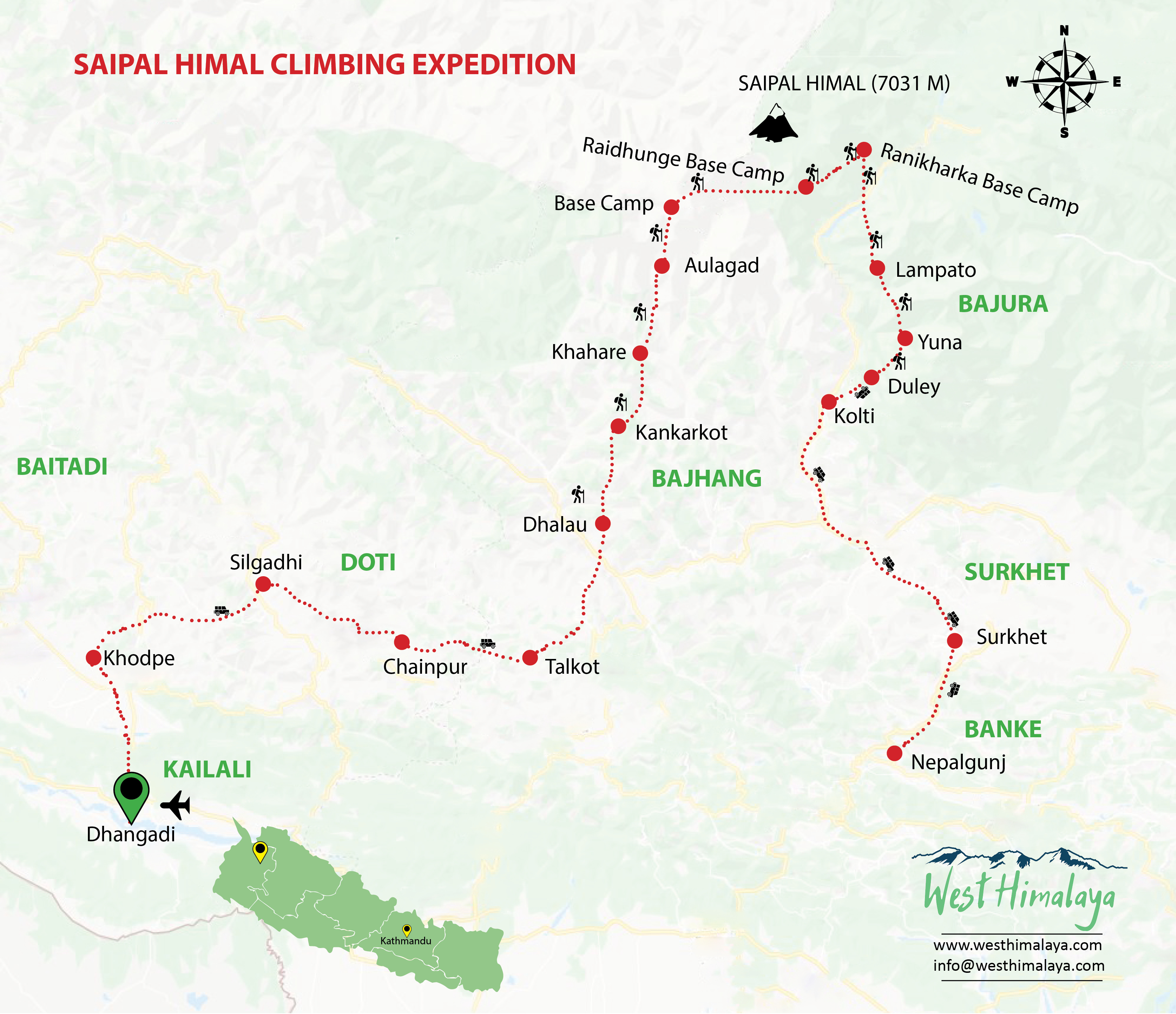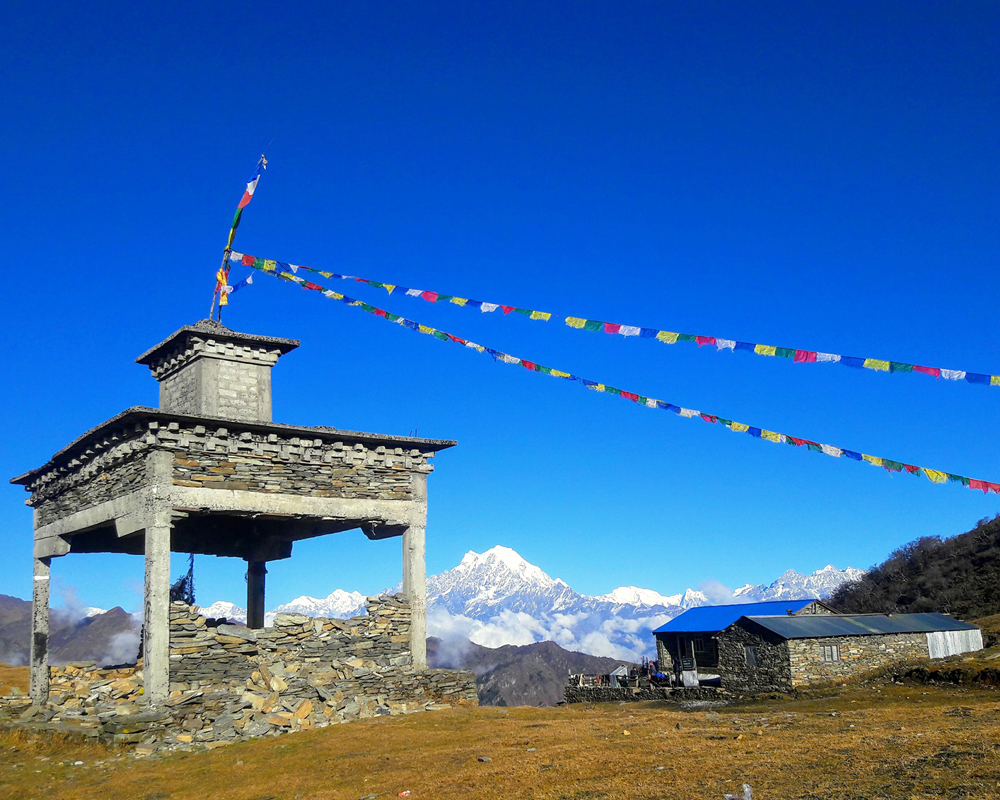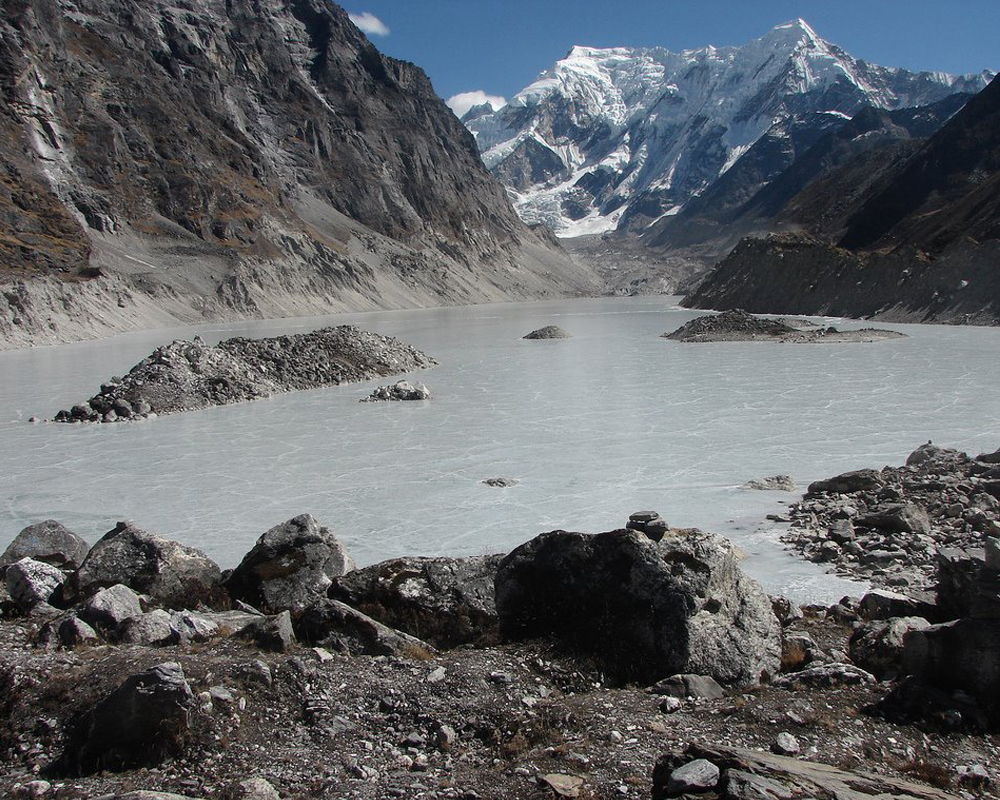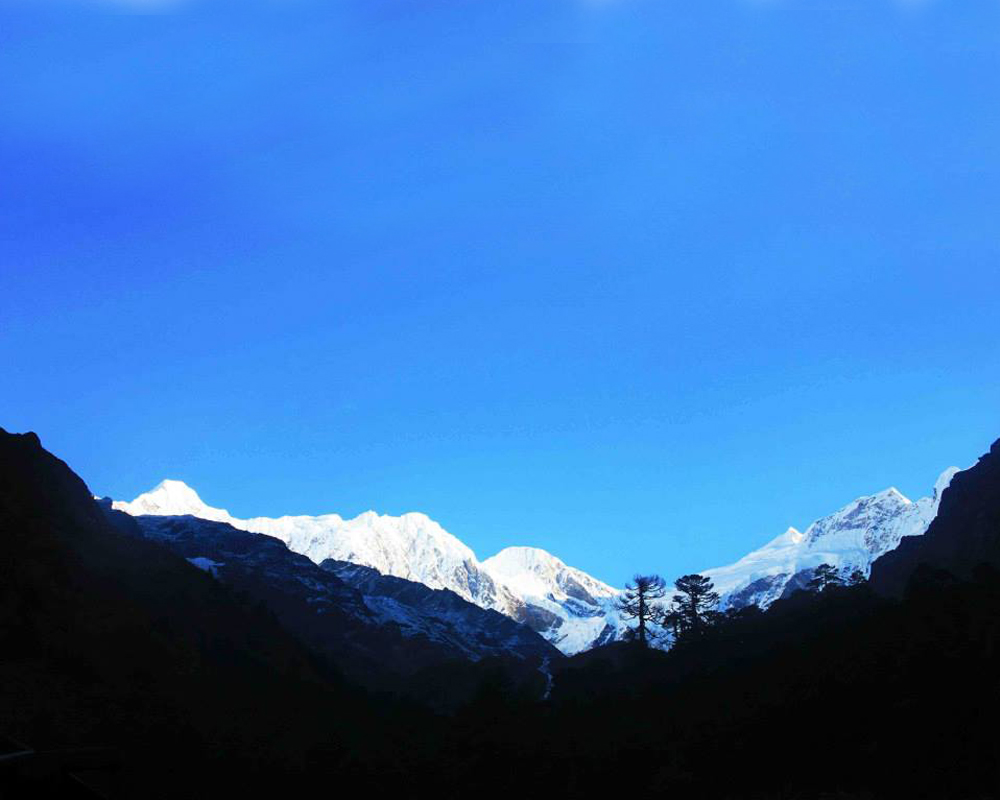- Climbing
- Saipal
Saipal Peak Climbing

Trip Highlights
-
Guided expedition to the summit of Saipal Himal
-
Amazing trek into the least-explored countryside of Bajhang district
-
Exeprience culture, tradition and lifestyle of the locals
-
Yak and goat caravans bringing supplies
-
Ancient Langa temples, high passes
-
Watch locals harvest medicinal herbs including Yarsagumba
-
Get a peek into the unique Masto - a cult of Hinduism

Overview
Trip Itinerary
Arrival
Welcome to Nepal. After completing customs and immigration formalities at the airport, meet our representative outside arrival terminal. Get transferred to your hotel. Remaining time is free for independent activities. In the evening, meet your guide and attend a trek briefing session.
O/N: HotelFly to Dhangadhi and drive to Dadeldhura (1300m) – Approx 1 hr flight, 4 hr drive
After breakfast, our representative will transfer you to the domestic terminal for your flight to Dhangadhi. The flight takes around an hour. After early lunch at Dhangadhi, board a waiting car for a drive to Dadeldhura. We drive on the Mahakali Highway which goes northward from the East West Highway. The drive is pleasing as the road passes through beautiful countryside, crossing rivers and rivulets, lush forests and terraced fields. Dadeldhura is a pleasing hilly town with cool weather. It offers breathtaking views of Api and Saipal mountains on a clear day.
O/N: HotelDrive to Talkot – Approx 7 hrs
Continue your drive today as you gradually gain altitude. Your destination for the day is your trek head start point at Talkot village. The drive is pleasing and on blacktopped road till Chainpur – the district headquarters of Bajhang. Chainpur is a beautiful town located on the banks of the magnificent Seti River. After having lunch, continue your drive toward Talkot. A drive of around two hours on a dirt road will take you to your destination in Talkot. Talkot is a small hilly settlement with 50-60 households. Brahmins and Chhetris are the major inhabitants. The village, however, as a glorious history as it used to be one of the 24 principalities of western Nepal before small princely states were unified into modern Nepal. In the evening, visit the historic Talkot palace.
O/N: Teahouse/TentTrek to Jadlek via Sunapani – Approx 5 hrs
First day of your trek! After early breakfast, follow the trail on the right bank of Seti River. The trail passes through forests and beautiful terrace. It is almost a leveled trek till your lunchpoint in Sunapani. Sunapani is a small hamlet by the side of a beautiful waterfall. After lunch, the trail to Kuwa is easy with small ups and downs. From Kuwa, however, it makes a descent for about half an hour to the village of Agra. Another downhill from the village will take you to Lisne Gaad river. Cross the river on a suspension bridge and walk uphill for about an hour on a forested trail to Jadlek – your destination of the day. Your camp will be setup in a small grassland surrounded by pine trees.
O/N: TentTrek to Dhalaun – Approx 4 hrs
Resume the walk after having breakfast at your camp. A steep climb of about half an hour will take you to a small pass. The pass has religious significance. Your support staff will worship their deity named ‘Lagan Devata’ at the pass, praying for the successful trip to Saipal. The pass offers view of the Saipal mountain range, but it is difficult to identify the peak from here. From the pass, the trail drops to a place called Ganai where there are few teahouses. Cross the Ganai Gaad River that originates from Dhalaun on a suspension bridge and follow the river northward to Dhalaun village. Dhalaun is a bustling village of about 150 households with a high school and health post. Your campsite will be set up near the school. As the lunch is prepared you can visit the village to experience the village life.
O/N: TentTrek to Khahare via Kakarkot – Approx 5 hrs
A walk of about one and half hours from Dhalaun will take you to another small pass named Nagma. The trail is uphill and tiring. But the view from the top is rewarding. You get first view of Mount Saipal from this pass. After spending sometime at the pass, you start descent toward Kakarkot where you will stop for lunch. The walk takes around one and half hours. There are few teahouses at Kakarkot which sits on a small ridge above Seti River that originates in Saipal Himal. After lunch, you start walking on the right bank of Seti River toward Khahare. The trail from here is narrow and used mostly by cattle herders. The trail is through small-statured bamboo, locally known as Nigalo, which means you are entering into the habitat of the elusive Red Panda. Khahare is a small pastureland by the side of a small stream.
O/N: TentTrek to Chitdka (lunch point) and continue to Dodhale – Appox 5 hrs
You continue your walk after having breakfast at your camp. The trail is leveled with minor ascents. As the trail passes through dense rhododendron, fir and walnut forests, you can see wildlife species like dear, beer and even red panda if you are lucky. A pleasing walk of around three hours will take you to Chitdka where your lunch will be prepared. Chitdka is a wonderful place. While your lunch is prepared, you can hear Seti River roaring below. You can also get clear view of Saipal range from here. Continue walked toward Dodhale. On the way, you will come across a beautiful waterfall which refreshes and rejuvenates you. The trail gradually gains altitude but it is not steep. A walk of some two hours from Chitdka will take you to Dodhale where you camp will be set up. Dodhale sits on the banks of two rivers that originate in Aunlagad and Raidhunge making it a perfect place for camping. You can get breathtaking views of Saipal range from here. Be prepared for a cold night, as you are entering the trans-Himalayan region.
O/N: TentTrek to south-western base camp of Saipal (4200m) via Aunlagad – Approx 5 hrs
Today, you will reach south-western base camp of Saipal Himal. We take the trail on the right of Aunlagad River and start climbing up. A walk of around two hours will take you to the Lower Base Camp at Aunlagad. The place provides you breathtaking view of Saipal Himal. After lunch, it takes leisurely walk of another two hours to reach southern-western base camp of Saipal. The base camp is an amazing ampitheatre as you are provided view of mountains all four sides. On the east lies the magnificent western face of Saipal Himal. You will also be rewarded with views of Kalapatthar, Sunapani range and Phirankov. There are several high-altitude pasturelands in the base camp. Your camp will be set up at one of those pastureland. From the base camp, you can see wild species like Himalayan Tahr and Blue Sheep, among others. Unlike in eastern Himalayas, you can see birch trees at such a high altitude.
O/N: TentHike to Upper Base Camp
Today, you will take a rest day for exploration of the base camp. With packed lunch in your backpack, your guide will take you for a hike to Upper Base Camp of Saipal Himal (5200 meters). You walk by the side of Aunlagad glaciers of Saipal Himal. The trail is difficult as you walk on the moraine of the glacier. A walk of about four hours will take you to the Upper Base Camp. The Upper Base Camp provides you possibly the best view of the Saipal Range. After lunch, start descending to your camp.
O/N: TentTrek to southern base camp (3800m) – Approx 5 hrs
You will trek to the Southern Base Camp of Saipal Himal today. Today, also you will be carrying packed lunch with you. After early breakfast, you take a trail to the east climbs up to a 5,000 pass. The pass provides breathtaking view of pastureland to the south and beautiful mountains to the north. After spending some time at the pass, start descending toward the southern base camp at Raidhunge. Raidhunge provides you view of another face of Saipal Himal. You can also see a glacier falling from the face of Saipal to a glacial lake from where Seti River originates.
O/N: TentRest day for acclimatization
Over the next two weeks, guides and Sherpas will fix climbing routes on the summit. You will be asked to and fro between different camps to acclimatize you at high altitude and make you familiar with the route. Guide will finalize the summit day based on your fitness level, route preparation and weather conditions. After the summit, return to the base camp.
O/N: TentTrek to Ranikharka – Approx 5 hrs
Fresh after the summit, start descending down to Nunkharka and then to Ranikharka. This will be a relatively shorter walk. Walk through glaciers and by glacial lakes to the wide meadows of Ranikharka. Ranikharka is one of the best places in the area to harvest Yarsagumba – the half caterpillar, half fungus which is believed to be a high-value aphrodisiac.
O/N: TentTrek to Lampato – Approx 7 hrs
The trail to Lampato is in a very good condition as it is a part of the ancient trade route with Tibet. It’s a busy trail as you will meet goat and mule caravans bringing sup lies, as well as people harvesting different medicinal herbs. The trail is mostly downhill and passes under canopy of thick forests. It takes around 7 hours to reach Lampato. Lampato literally means a strip of flat land.
O/N: TentTrek to Yuna – Approx 7 hrs
This is going to be a bit longer day today. Continue walking on the banks of Kawadi Khola. While walking down, you can witness change in vegetation. Instead of small shurbs, you can see tall trees with big canopy. You pass through the beautiful villages, including Gumba, as you follow down to Yuna.
O/N: TentTrek to Duley – Approx 6 hrs
This is going to be the last walking day of your trek. Continue walking following Kawadi Khola. The route gets busier as compared past few days as you meet students, traders and local villagers on the trail. A walk of about six-seven hours will take you to Duley which sits near the confluence of Kawadi Khola and Karnali Khola that originates in Tibet and flows through Humla and Bajura. As today is the last walking day of your trek, party with the crew members who will be leaving you here.
O/N: TentDrive to Mangalsen
After breakfast, board a waiting car and start driving toward. Expect some bumpy ride as the road is in a bad shape initially. Stop at Kolti – the administrative headquarters of Bajura – for lunch and start driving toward Mangalsen of Achham.
O/N: HotelDrive to Surkhet
Continue driving toward Surkhet. Surkhet is the provincial headquarter of Karnali Province. You get all the amenities here. The road is not in a good shape as it is still under construction. Upon arrival in Surkhet, check into your hotel.
O/N: HotelDrive to Nepalgunj and fly to Kathmandu
After early breakfast, start driving toward Nepalgunj Airport. The drive takes around 4 hours and you will reach there by lunch time. After lunch, board your aircraft and fly to Kathmandu. Upon arrival in Kathmandu, check into your hotel.
O/N: HotelLeisure Day in Kathmandu
It’s a leisure day in Kathmandu. You can just stay in your hotel room to unwind yourselves after nearly three weeks in the Himalayas or go shopping to buy souvenirs for friends and family back home. We can arrange sightseeing and other activities on request. In the evening, we will organize a farewell dinner at a restaurant serving typical Nepali food to celebrate your success. You can discuss the trip and share your experiences or plan for your next trip while enjoying the meal.
O/N: HotelDeparture
After a leisurely breakfast, our representative will escort you the airport for your return flight. Our representative will ensure that you reach the airport at least three hours before your flight time so that you don’t have to rush through customs and immigration formalities. Goodbye until we meet again.
O/N: HOtelNeed Assistance?
If you want to customize your trips, need any logistics or permits for filming, guidance for climbing and rafting then feel free to contact us directly and start planning your trip to Nepal.
Bhoj Raj Bhat
+977 9851087675This email address is being protected from spambots. You need JavaScript enabled to view it.
Bishnu Bhattarai
+977 9851230792This email address is being protected from spambots. You need JavaScript enabled to view it.
Book this tour
Equipment List
-
Alpine Climbing HarnessIt should be simply designed, light and easy to carry with positively foolproof features.
-
CramponsIt should be fitted with boots perfectly, still crampons with anti-balling and safely into ice.
-
Ice AxeUsed to cut off the ice during climbing should be versatile light.
-
AscenderAlso known as Jamar, used for ascending on a rope, should be flexible to use with gloves or mittens.
-
Head LampMulti LED headlamp with spare batteries is essential.
-
CarabinersA minimum of two locking carabiners (large and small) and 4 regular carabiners.
-
Rappel DeviceFigure eight, ATC device or similar.
-
Ski PolesVery handy for the approach; adjustable types are the best and are recommended type.
-
SlingsOne 3m/10ft and three 2m/6ft
-
Altimeter Watch
-
Climbing HelmetsShould be light and comfortable.
Clothing
Upper Body
-
Warm sleeved T-shirts
-
Fleece pullover.
-
Fleece jacket.
-
Waterproof and breathable jacket with a large hood to accommodate climbing helmet.
-
Lightweight down jacket for chilly days in base camp or warm layer when stopping for short breaks.
-
Warm goose-down (duvet) jacket with hood or a down/duvet suit if you prefer, for high altitude use.
Lower Body:
-
Briefs
-
Walking shorts for trek
-
Walking trousers for trek
-
Two pair of thermal bottoms
-
One pair of 200 thermal bottoms
-
A pair of fleece trousers
-
A pair of waterproof/breathable trousers with full side zips
-
A pair of Goose-down (duvet) trousers or bibs.
Hands
-
A pair of lightweight poly-liner gloves.
-
A pair of mittens.
Heads
-
Warm wool or synthetic hat that covers your ears
-
Balaclava
-
Scarf or neck sleeve
-
Face mask
-
Ballcap or brimmed sun cap
-
Sunglass with side shields
-
Ski goggles
-
Bandana or headscarf
Sleeping Gears
-
One down (duvet) sleeping bag (rated to –35 C). In the high camp, you can sleep in your down (duvet) clothing inside your sleeping bag;
-
For base camp, one additional sleeping bag (good to -20 C).
-
Three closed cell foam mats for use in base camp and high altitude. We do not recommend inflatable mats due to a high probability of accidental puncture.
Feet
-
A pair of good quality plastic shells with inner boots.
-
A pair of sturdy leather or synthetic hiking boots with good ankle support for the walk to advanced base camp
-
A pair of cross-trainers, running shoes and/or sandals
-
Two pairs of med-heavy poly or woolen socks.
-
Two pairs of polypropylene or woolen sock liners.
-
Vapor barrier liner socks or plastic bread-bags
-
Two pairs of lightweight trekking socks, poly or wool
-
Two pair of cotton sock
Travel Gears
-
One Medium Rucksack (50-70 liters/3000-4500 cubic inches)
-
Two large (120 liters/7500 cubic inches) duffle kit bags for clothing and equipment.
-
Small padlocks for duffel kit bags.





